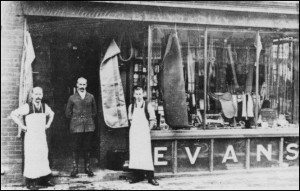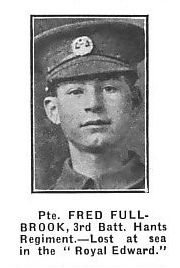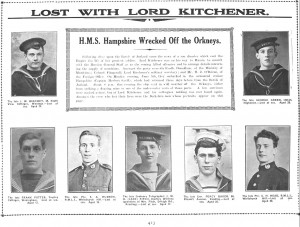
Peach Street, Wokingham. Charles Rideout is the young man wearing the apron on the right hand side. He was killed during the Battle of Loos, 1915.
Here is a short summary of the main events of The Great War and links have been added to explain them in greater detail.
1914. On the 28th June 1914, the Austria-Hungarian Empire’s Archduke Franz Ferdinand, was murdered by Gavrilo Princip, a Bosnian Serb nationalist. Austria-Hungary blamed Serbia for the killing and because Europe was linked by a series of diplomatic alliances – Austria-Hungary/Germany/Italy (Central Powers) and Britain/France/Russia (Triple Entente/Allied forces) – the assassination escalated into full-scale war.
The German Army marched into Belgium with the intent of entering Paris before Russia was ready to engage its forces. With Belgium’s neutrality now compromised, Britain was forced to declare war on Germany on the 4th August 1914.
By September 1914, the Central Powers and Allied Forces were attempting to outflank each other, causing a series of defences and trenches which spread for 460 miles along southern Belgium and northern France. Vast numbers of men, heavy and light artillery and underground accommodation dug deep into the soft chalky soil, ensuring the war was to last for years.

Fred Fullbrook lived in Havelock Place, just at the back of Wokingham’s railway station. The fact he was lost at sea, illustrated the treacherous nature of the Gallipoli campaign.
1915. Battles at Ypres in Belgium in October 1914 and April of 1915, were not enough to force a conclusion to the war, even by the introduction of chlorine gas. Germany was also fighting Russia on their eastern front, succeeding both militarily and choking supplies via the Black Sea. Churchill planned to open up the entrance to the Black Sea at the Dardanelles, but would need to break the resistance of the resident Turks first. After over 8 months in January 1916, the campaign ended on the peninsular of Gallipoli, inflicting losses of nearly 400,000 men from both sides.
Gallipoli represented a year of general failure for the Allies; 1915 also saw the professional army and the reserve forces virtually eliminated. The British war effort also was blighted by a lack of equipment and munitions, culminating in another failure at the Battle of Loos. At the end of 1915, Sir John French was replaced by Douglas Haig as Commander of the Armed Forces and along with the Government, the war effort began to be reorganised. Kitchener’s volunteer army was however, to face its greatest challenge on the River Somme.

Frank Potter (bottom left), named on the Wokingham War Memorial, was drowned with Lord Kitchener on HMS Hampshire.
1916 After spending 1915 in defensive positions, Germany took the initiative with an attack on the French stronghold of Verdun. From February to July 1916, the Battle of Verdun had cost the French forces 350,000 deaths and they were in desperate need of relief. On July 1st, the British attacked at the nearby River Somme. German troops were drawn away from Verdun to support their defences, thereby relieving the French lines. After months of British effort however, the Battle of the Somme came to an end in the November at a cost of 420,000 lives from the British Empire. Most of the losses came from Kitchener’s Volunteer Army.
Until June 1916, there had been no major battle between the two great navies of Britain and Germany. The British naval position in the Orkneys was perfect as it could lie in wait for a German fleet which ventured away from its Baltic ports. In the June of 1916, the two fleets met at Jutland and fought to an inconclusive end, but the damage to the German ships kept them in port until the end of the war.
By 1916, Britain had seen their army numbers depleted and were forced to introduce conscription, but had also seen the whole of the country in full war production. Germany also suffered losses, this time on both eastern and western fronts and they had also failed in their attempts to overcome Britain’s navy. Their U Boats were reducing Britain’s merchant supplies across the Atlantic Ocean, but were testing the patience of the world’s new industrial powerhouse. America was about to enter the war on the side of the Allies.
1917 was a year of revolution, mutiny, invention and innovation. The British Empire forces had by now established a modern army and (with the French Army at the point of exhaustion) took on the leadership of the Allied campaign. The Germans resolved to unrestricted submarine warfare in the Atlantic, which included USA merchant ships. Germany also proposes an alliance with Mexico to attack America in return for the southern states of Texas, New Mexico and Arizona. Inevitably, America declared war on Germany.
At Cambrai, the British introduced a full attack with their new invention, the tank – with some success. At Arras, the Canadians took Vimy Ridge for the Allies. The British Army had learned the lessons of modern warfare and were fighting in smaller, responsive units and varied their methods of attack. The Russians and the French however, were exhausted from the war, having taken on most of the German firepower since 1914. The Russians fell into revolution and withdrew from the war. The French mutinied after another senseless attack at Chemin des Dames. The Germans were buoyed by the failure of the British assault at Passchendaele and saw an opportunity to win the war following the withdrawal of the Russians on their eastern front.
1918. With the withdrawal of Russia from the war, Germany could now move its additional forces to the Western Front and use them to end their defensive positions and take the war to the Allies. The German Army’s leader, Erich Ludendorf figured he would need to achieve victory before the Americans land in numbers. His ‘Spring Offensive’ almost achieved its objectives and even forced Haig to turn to his troops and tell them there would be no retreat, it would be ‘backs to the wall’ and a fight to the end. During these series of attacks, the British suffered some of their greatest losses of the war, but the German offensive petered out with the support units unable to keep up with the speed of the attack, as well as a lack of resources brought about by the success of Britain’s naval blockade. The Allies, with refreshed French support, a growing American presence and a skilled, well supplied British Army, bounced back on the counter attack. The attacks are irrepressible and the end finally comes on the 11th November 1918, when a German delegation signs the Amnesty which ends the war.
The Government of New South Wales also offers an interesting summary of the Great War.
